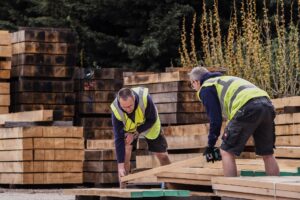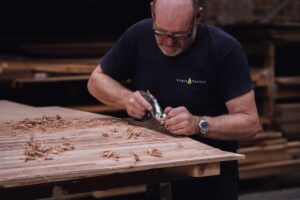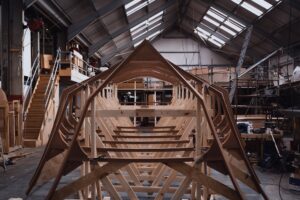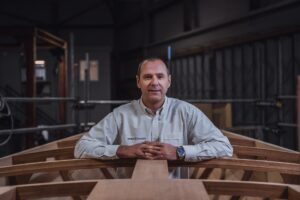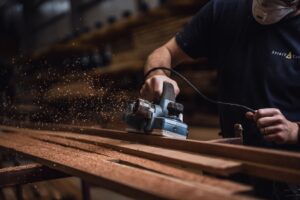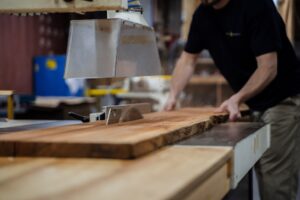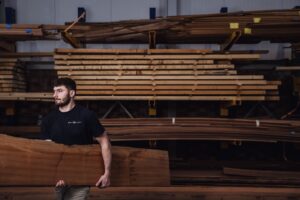
WHY DOES SPIRIT YACHTS BUILD IN WOOD?
A question we are often asked is why do we build yachts in wood? In a world where marinas are packed with GRP (glass-reinforced plastic), there is no doubt a wooden yacht stands out from the crowd. It is hard to find anyone who cannot admire and respect the beauty of a wooden yacht, but are there other advantages to building in wood? And how does it match up to other materials when it comes to the environment?
On a recent trip to the timber suppliers with Spirit Yachts’ Yard Manager Adrian Gooderham, we delved into the why behind wooden yacht building.
Adrian comments, “Wood is a natural material, which comes with many positives. From how it feels, to the smell when you cut it, and the gleam of a varnished surface. Wood is tactile, warm, and elegant – it also has an impressive strength to weight ratio. From an environmental perspective, if you are sourcing the timber from responsibly managed forests, with a robust and transparent supply chain, you are using a renewable resource.”
Trees absorb carbon dioxide from the atmosphere during growth, effectively storing it in their biomass (every element of the tree, living or dead). This means responsibly harvested wood can play an important role in carbon capture (or sequestration).
Family-run Sykes Timber has been supplying high quality hard and soft woods for over 160 years.
Joe Sykes, the latest generation to join the business, says, “Timber is the only truly renewable building material—it literally grows back. If you look at general building materials like concrete and steel, which require vast amounts of energy and emit enormous amounts of CO₂ during production, timber is a carbon sink, absorbing CO₂ from the atmosphere as it grows. Every cubic metre of wood used in construction can store around 1 tonne of CO₂, whereas producing 1 tonne of steel releases around 1.8 tonnes of CO₂.”
Sykes Timber sources wood from responsibly managed forests where trees are replanted faster than they are harvested. The company’s in-house compliance officer ensures the supply chain from the forest to the mill. The shipping process is carefully checked and the timber adheres to FSC and PEFC certification standards. This information is shared with Spirit Yachts for complete transparency up and down the chain.
Joe regularly visits the forests himself to meet the local teams managing the forests and to grade the timber. “Our family business has been visiting forests and mills for over 160 years – quality and provenance are at the heart of what we do. We work with companies that support and protect their employees, animal habitats, and the local community. When we first visited Spirit Yachts, we could immediately see they share our passion for high grade timber and the credibility of its sourcing.”
After a look around the Sykes Timber yard in central England, Adrian gets to work inspecting a batch of timber due to be delivered to Spirit Yachts the following week.
Adrian says, “I’m looking at the pattern and tightness of the grain, the width and length of the planks, and whether there are any defects in the wood such as knots, splits, sap pockets or medullary rays (‘tiger stripe’ marks in the timber caused by plant cell growth).”
No timber is wasted, Sykes ensures every offcut is either resold in their onsite hobby shop or used to heat their offices and mills in wood boilers, sawdust is collected by local farms for livestock bedding. At Spirit Yachts, any unused wood is donated to local boatbuilding colleges and charity projects.
As well as the environmental argument, Adrian explains the impressive strength to weight ratio of wood makes it an effective material for boatbuilding.
He says, “All timbers have strengths and weaknesses, each species is unique and that is why it’s important to select the right type and to know what you are looking for. When tension is run along the same direction as the grain, wood absorbs high loads very effectively. By using the timber’s characteristics to our advantage, we can produce yachts that are relatively light for their size, but they also have high strength properties.”
In comparison to boats made using a mould (often carbon or GRP), wood allows Spirit Yachts to be creative in its customisation for each owner, particularly on a yacht’s interior.
Lead Designer Tom Smith comments, “Our craftsmen and women thrive on the opportunity to make bespoke pieces and we ensure every element of the yacht has timeless beauty as well as a practical purpose. I love the challenge of seeing how creative the team can be – wood allows us to push boundaries in design that wouldn’t otherwise be available.”
The flexibility of wood also allows Spirit to give new life to older yachts, helping to keep them in circulation for generations to come.
Adrian explains, “A good example is a P40 motor yacht now in her third iteration – she started as an open yacht, transitioned to a fully enclosed boat, and she is now in Italy after a recent refit as a semi-enclosed day boat.
“The ability to keep upgrading and modifying our yachts to suit the next generation of yacht owners means we can help overcome the ‘end of life issue’ that affects so many GRP production yachts. Not only that, if the day ever comes when a Spirit really has reached the end of her life, the yacht can be stripped of her component parts and the timber hull can be re-used or upcycled.”
To find out more about how and why Spirit Yachts builds with wood, and a look at the timber selection process, check out The Spirit of Excellence video series on Youtube: click here. Episode 3 takes a look into what signifies a quality timber and accompanies Adrian on a visit to Thorogood Timber. Click here to watch Episode 3.
Photos: Luke Dorey / Volano Media & Waterline Media
RELATED ARTICLES
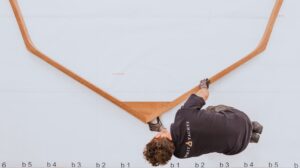
SPIRIT YACHTS LAUNCHES ‘SPIRIT OF EXCELLENCE’ VIDEO SERIES
Take an exclusive look behind the scenes at Spirit Yachts and gain insight into the design and build process.
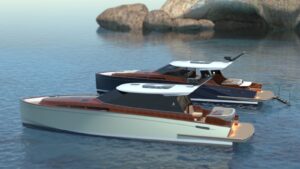
SPIRIT YACHTS REVEALS NEW P50 MOTOR YACHT
Spirit Yachts has unveiled its latest new designs, the P50 Coupé and the P50 Sport, with one of each already in build
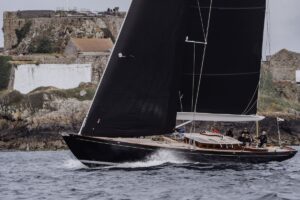
ELVIS BRINGS ROCK ‘N’ ROLL TO SPIRIT YACHTS
Hear from the owner of Spirit C72 Elvis as he describes his first season of racing and cruising.

